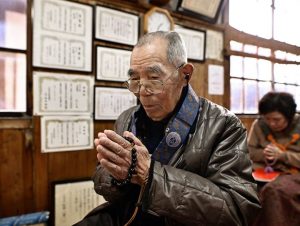Documenting Hiroshima, Witnesses to horrors of atomic bombing: Masayoshi Yokomaru, resident of Kawauchi, Asaminami Ward, “Pika Village,” mother, children lead difficult lives after war
Mar. 13, 2025
by Michiko Tanaka, Senior Staff Writer
On the early afternoon of the 6th of each month, Masayoshi Yokomaru, 94, of Kawauchi, Asaminami Ward of Hiroshima, goes to the local community center. His unfaltering steps belie his age. “I've been working in the fields since I was a kid, so I have strong legs,” he said with a beaming smile.
The 6th is the monthly return of the date of his father, Masaru Yokomoru’s death. He died in the atomic bombing on August 6, 1945, in the city center about 10 kilometers south of the village. As a member of the Kawauchi Village Volunteer Corps, he was mobilized to work on creating a firebreak. Preparing for the decisive fighting on the mainland, the national government ordered volunteer corps be organized in each region and company. About 200 members of the Kawauchi volunteer corps, including Masaru, were killed. In fact, 10 % of the village’s population was killed, and Kawauchi was later called “Pika Village.” (Pika is a Japanese word describing the flash of the atomic bombing.)
The area is home to many followers of the True Pure Land sect of Buddhism. The first monthly memorial service is said to have been held at Jogyo-ji Temple in the village in September 1945. Before long, memorial services began to be held at the community center as well. Even 80 years after the war, around 10 people still come to attend. They invite the temple’s priest and chant the sutras with the priest.
“I guess this was one of the few sources of comfort for my mother,” said Mr. Yokomaru. His mother, Tsuyuko, died in 1998 at the age of 88. She never missed a monthly service until the end of her life. “She worked hard all her life. She really went through hardships.”
On that fateful day, his mother lost the breadwinner of the family. All that was left were four sons, a daughter, and a few fields. The eldest son, Mr. Yokomaru, was 14 at the time. He also had to live through the harsh postwar period.
(Originally published on March 13, 2025)
On the early afternoon of the 6th of each month, Masayoshi Yokomaru, 94, of Kawauchi, Asaminami Ward of Hiroshima, goes to the local community center. His unfaltering steps belie his age. “I've been working in the fields since I was a kid, so I have strong legs,” he said with a beaming smile.
The 6th is the monthly return of the date of his father, Masaru Yokomoru’s death. He died in the atomic bombing on August 6, 1945, in the city center about 10 kilometers south of the village. As a member of the Kawauchi Village Volunteer Corps, he was mobilized to work on creating a firebreak. Preparing for the decisive fighting on the mainland, the national government ordered volunteer corps be organized in each region and company. About 200 members of the Kawauchi volunteer corps, including Masaru, were killed. In fact, 10 % of the village’s population was killed, and Kawauchi was later called “Pika Village.” (Pika is a Japanese word describing the flash of the atomic bombing.)
The area is home to many followers of the True Pure Land sect of Buddhism. The first monthly memorial service is said to have been held at Jogyo-ji Temple in the village in September 1945. Before long, memorial services began to be held at the community center as well. Even 80 years after the war, around 10 people still come to attend. They invite the temple’s priest and chant the sutras with the priest.
“I guess this was one of the few sources of comfort for my mother,” said Mr. Yokomaru. His mother, Tsuyuko, died in 1998 at the age of 88. She never missed a monthly service until the end of her life. “She worked hard all her life. She really went through hardships.”
On that fateful day, his mother lost the breadwinner of the family. All that was left were four sons, a daughter, and a few fields. The eldest son, Mr. Yokomaru, was 14 at the time. He also had to live through the harsh postwar period.
(Originally published on March 13, 2025)








